AUDI A5 COUPE 2014 Owners Manual
Manufacturer: AUDI, Model Year: 2014, Model line: A5 COUPE, Model: AUDI A5 COUPE 2014Pages: 286, PDF Size: 70.99 MB
Page 171 of 286
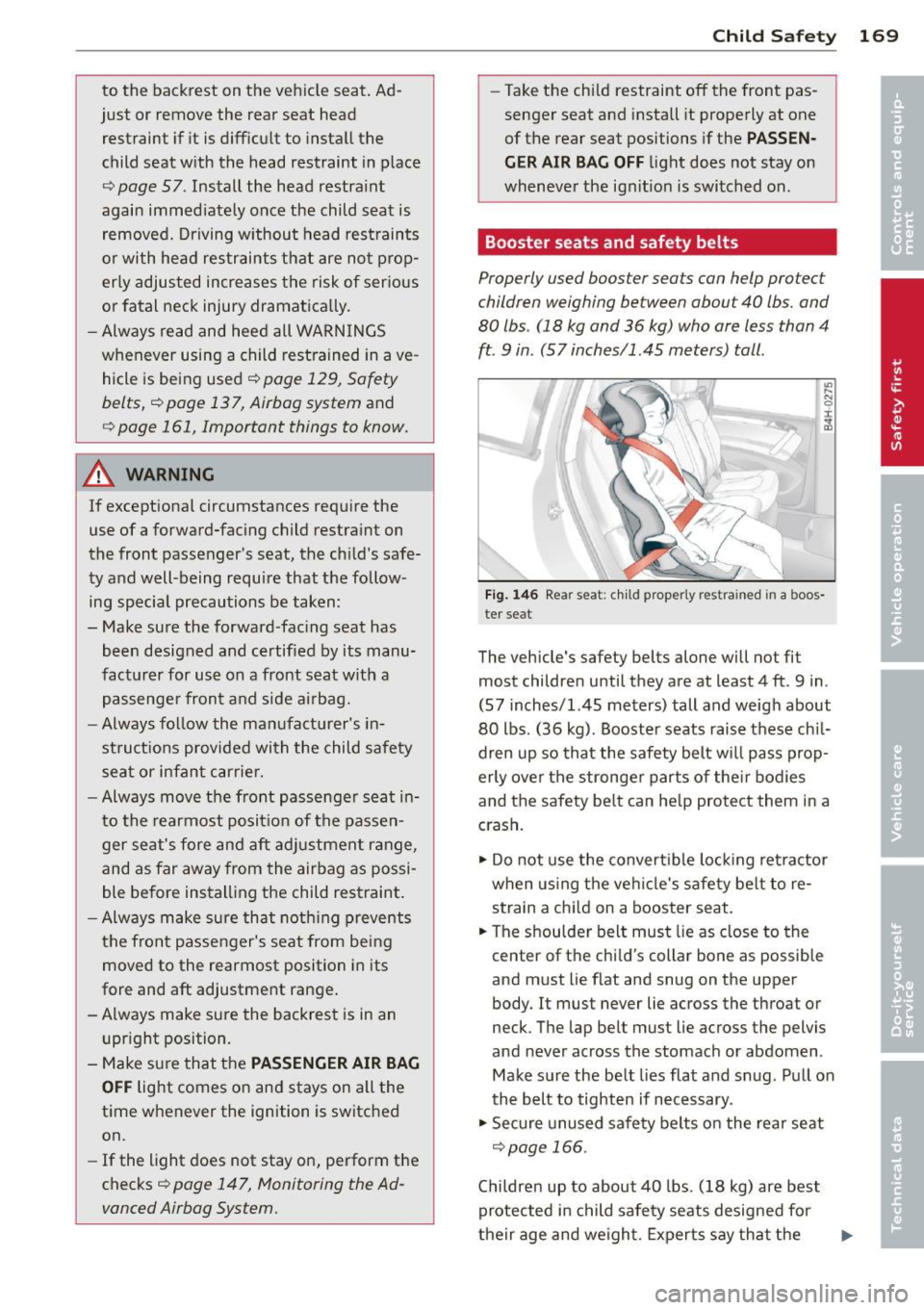
to the backrest on the veh icle seat. Ad
just or remove the rear seat head restraint if it is diff icult to install t he
child seat w ith the head restraint in place
¢ page 57. Install the head restraint
again immed iate ly once the child seat is
removed. Driving without head rest raints
o r with he ad restraints that are not prop
erly adjusted increases the risk of serious
or fatal neck injury dramatica lly.
- Always read and heed all WARN INGS
whenever using a child rest rained in ave
hicle is being used
¢page 129, Safety
belts,
¢ page 13 7, Airbag system and
¢ page 161, Important things to know.
A WARNING
If except ional circumstances requ ire the
use of a forward-facing child restra int on
the front passenger's seat, the ch ild's safe
ty and well-being require that the follow
ing special precautions be taken:
- Make sure the forward-fac ing seat has
been designed and certified by its manu
factur er for use on a front seat with a
passenge r fron t and side airbag.
- Always follow the manufact urer's in
st ruct ions provided with the child safety
sea t or infan t carrier.
- Always mov e the front passenge r sea t in
to the rearmost posit io n of the passen
ger seat's fore and aft ad justment r ange,
and as far away from the airbag as possi
ble before instal ling the child restraint.
- Always make sure that noth ing prevents
the front passenger's seat from bei ng
moved to the rearmost position in its
fore and aft adjustment range .
- Always make sure the backrest is in an upr ight position.
- Make su re that the
PASSENGER AIR BAG
OFF
light comes on and stays on all the
time whenever the ignition is switched
on.
- If the light does not stay on, perform the
checks¢
page 147, Monitoring the Ad
vanced Airbag System.
-
Child S afety 169
- Ta ke the chi ld restraint
off the front pas
senger seat and install it properly at one
of the rear seat positions if the
PASSEN
G ER AIR BAG OFF
light does not stay on
whenever the ignit ion is switched on.
Booster seats and safety belts
Properly used booster seats con help protect
children weighing between about 40 lbs. and
80 lbs . (18 kg and 36 kg) who are less than 4
ft.
9 in . (57 inches/1 .45 meters) tall.
In .... N 0 ±
~
Fi g. 14 6 Rear seat: ch ild properly res trained in a boos
ter seat
The vehicle's safety belts alone w ill not fit
most children until they are at least 4
ft. 9 in .
(57 inches/1.45 me ters) tall and weigh about
80 lbs .
(36 kg). Booster seats rais e these chi l
dren up so tha t the safety belt w ill pass p rop
erly over the stronger parts of the ir bodies
and the safety be lt can he lp protect them in a
crash.
.,. Do not use the convert ible lo cki ng ret ra ctor
when using the ve hicl e's s afety be lt to re
s train a ch ild on a booster seat.
... The shoulde r belt must lie as close to the
center of the ch ild's collar bone as possible
and must lie flat and snug on the upper
body. It must never lie across the throat or
neck . The lap be lt must lie across the pelvis
and never across the stomac h or abdomen .
Make s ure the belt lies flat and sn ug. Pull on
th e belt to tighten if necessary.
.,. Se cure unused safety belts o n the rear seat
¢page 166.
Children up to about 40 lbs . (18 kg) are best
protected in child safe ty seats designed for
their age and we igh t. Experts say th at the
Page 172 of 286
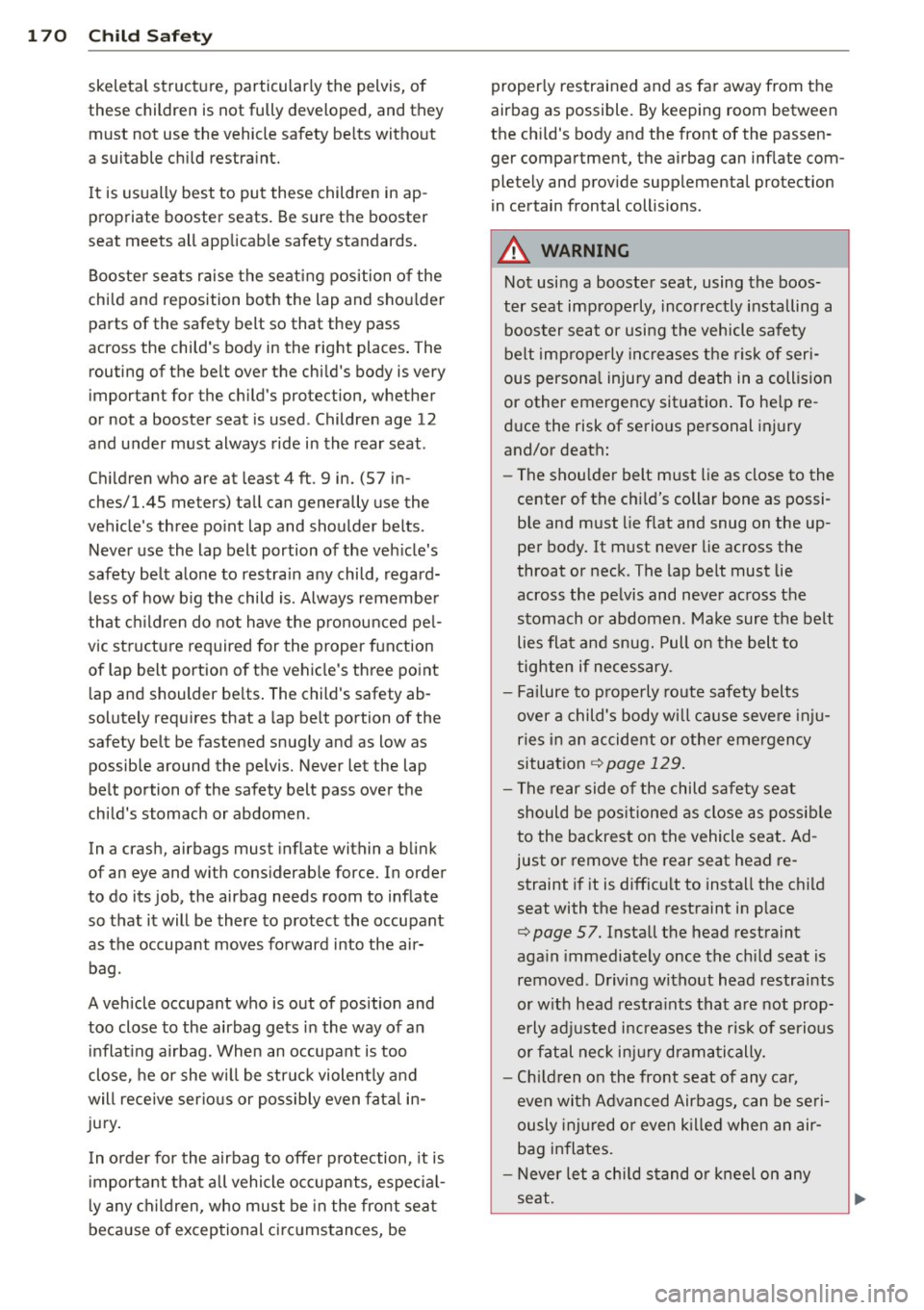
1 70 Child Safety
skeletal structure, particularly the pelvis, of
these children is not fully developed, and they must not use the vehicle safety belts without
a suitable child restraint.
It is usually best to put these children in ap
propriate booster seats. Be sure the booster
seat meets all applicable safety standards.
Booster seats raise the seating position of the
child and reposition both the lap and shoulder
parts of the safety belt so that they pass
across the child's body in the right places. The routing of the belt over the child's body is very
important for the child's protection, whether
or not a booster seat is used . Children age 12
and under must always ride in the rear seat.
Children who are at least 4 ft. 9 in. (57 in
ches/1.45 me ters) tall can generally use the
vehicle 's three point lap and shoulder belts .
Never use the lap belt portion of the vehicle's
safety belt alone to restrain any child, regard less of how big the child is. Always remember
that children do not have the pronounced pel
vic structure required for the proper function
of lap belt portion of the vehicle's three point lap and shoulder belts. The child's safety ab
solutely requires that a lap belt portion of the
safety belt be fastened snugly and as low as possible around the pelvis. Never let the lap
belt portion of the safety belt pass over the
child's stomach or abdomen.
In a crash, airbags must inflate within a blink
of an eye and with considerable force. In order
to do its job, the airbag needs room to inflate
so that it will be there to protect the occupant
as the occupant moves forward into the air bag.
A vehicle occupant who is out of position and
too close to the airbag gets in the way of an
inflating airbag. When an occupant is too
close, he or she will be struck violently and
will receive serious or possibly even fatal in
jury.
In order for the airbag to offer protection, it is
important that all vehicle occupants, especial
ly any children, who must be in the front seat
because of exceptional circumstances, be properly restrained and as far away from the
airbag as possible. By keeping room between
the child's body and the front of the passen ger compartment, the airbag can inflate com
ple tely and provide supplemental protection
in certain frontal collisions .
A WARNING
-Not using a booster seat, using the boos-
ter seat improperly, incorrectly installing a
booster seat or using the vehicle safety
belt improperly increases the risk of seri
ous personal injury and death in a collision
or other emergency situation. To help re
duce the risk of serious personal injury
and/or death:
- The shoulder belt must lie as close to the
center of the child's collar bone as possi
ble and must lie flat and snug on the up
per body. It must never lie across the
throat or neck . The lap belt must lie
across the pelvis and never across the
stomach or abdomen. Make sure the belt lies flat and snug. Pull on the belt to
tighten if necessary .
- Failure to properly route safety belts
over a child's body will cause severe inju
ries in an accident or other emergency
situation ¢
page 129.
- The rear side of the child safety seat
should be positioned as close as possible
to the backrest on the vehicle seat. Ad
just or remove the rear seat head re
straint if it is difficult to install the child
seat with the head restraint in place
¢
page 57. Install the head restraint
again immediately once the child seat is
removed . Driving without head restraints
or with head restraints that are not prop
erly adjusted increases the risk of serious
or fatal neck injury dramatically.
- Children on the front seat of any car,
even with Advanced Airbags, can be seri
ously injured or even killed when an air
bag inflates.
- Never let a child stand or kneel on any
seat .
-
Page 173 of 286
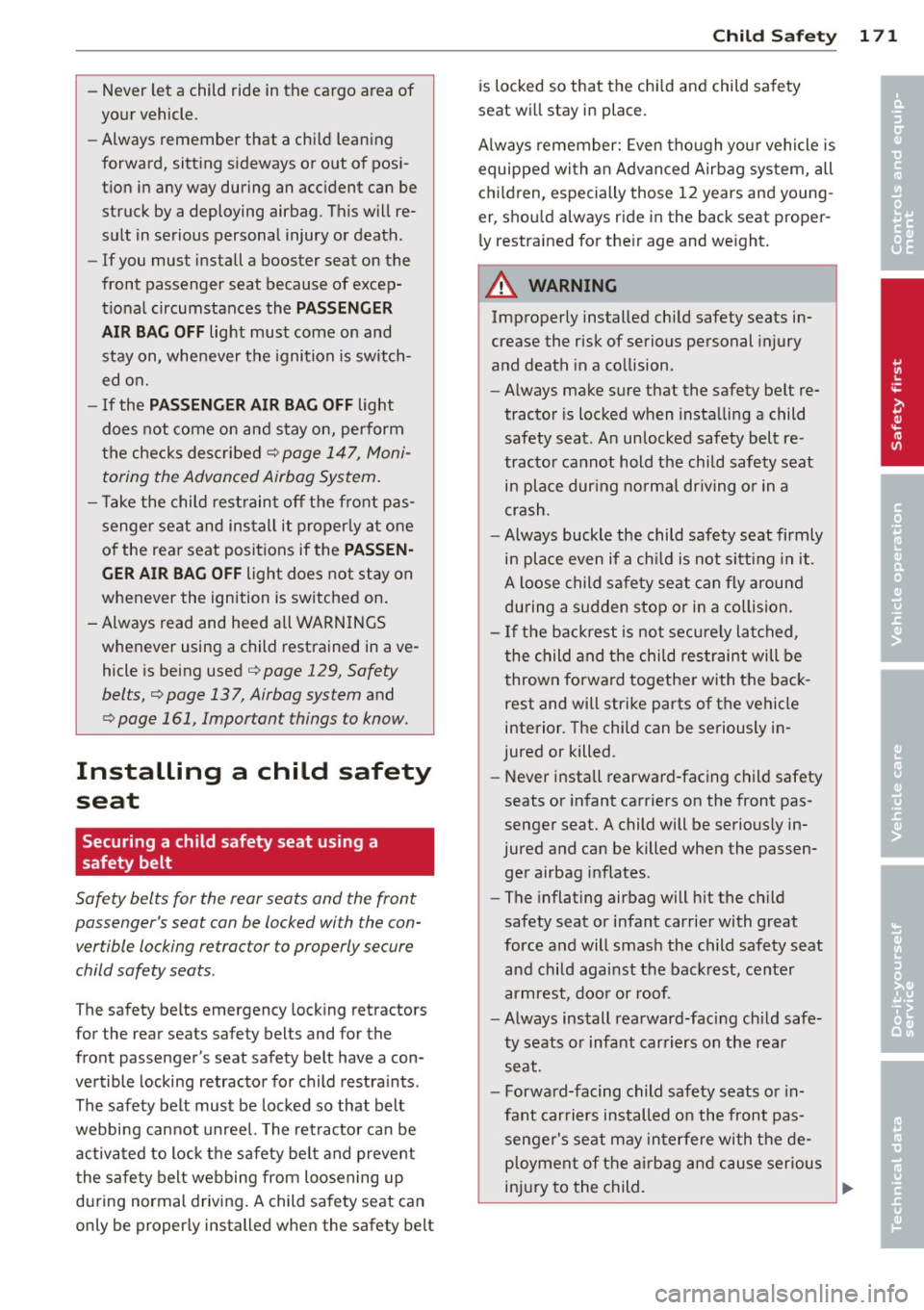
-Never let a child ride in the cargo area of
your vehicle.
- Always remember that a chi ld leaning
forward, sitting sideways or out of posi
t ion in any way during an acc ident can be
struck by a deploying airbag. This will re
sult in serious personal injury or death.
- If you must install a booster seat on the
front passenger seat because of excep
t ional circumstances the
PASSENGER
AIR BAG OFF
light must come on and
stay on, whenever the ignition is switch
ed on.
- If the
PASSENGER AIR BAG OFF light
does not come on and stay on, perform
the checks described
¢ page 147, Moni
toring the Advanced Airbag System.
- Ta ke the child rest rain t off the fron t pas
senger seat and ins tall it proper ly a t one
of the rear seat posi tions if the
PASSEN
GER AIR BAG OFF
light does not stay on
whenever the ignition is switched on .
- Always read and heed all WARNINGS
whenever using a child restrained in ave
hicle is being used
¢page 129, Safety
belts,¢ page 137, Airbag system
and
¢ page 161, Important things to know.
Installing a child safety
seat
Securing a child safety seat using a
safety belt
Safety belts for the rear seats and the front
passenger's seat can be locked with the con
vertible locking retractor to properly secure
child safety seats .
The safety belts emergency lock ing retractors
for the rear seats safety belts and for the
fro nt passenger's seat safety belt have a con
vertible locking retracto r fo r child restra ints .
The safety belt must be locked so that belt
webbi ng cannot unreel. The retracto r can be
activ ated to lock t he safety be lt and p revent
t he safe ty belt webbing from loosening up
d uring normal driving . A child sa fety seat can
only be properly installed when the safety belt
Child Sa fet y 1 71
is loc ked so that the chi ld and child sa fety
seat wi ll stay in place.
A lw ays remember: Even tho ugh yo ur vehicle is
equipped with an Advanced Airbag system, all
c hi ldren, especially those 12 years and young
er, sho uld always ride in the back seat prope r
l y restrained for the ir age and we ight .
A WARNING
Imp roperly installed chi ld safety seats in
crease the risk of serious personal injury
and deat h in a co llision.
- Always make sure that the safety belt re
tracto r is locked when insta lling a child
safety seat. An unlocked safety belt re
trac to r cannot hold the child safety seat
in place dur ing norma l dr iving o r in a
crash.
- Always buckle the child safety seat firmly
in place even if a ch ild i s not si tt ing in it.
A loose child safe ty seat can fly aroun d
du ring a sudden stop or in a collision.
- If the backrest is not securely la tched,
the child and the child re5traint will be
thrown forward togethe r with the bac k
rest and will strike parts of the vehicle
interior. The child can be se riously in
jured or killed.
- Never install rearwa rd-facing child safety
seats or infant ca rrie rs on the front pas
senger seat. A child will be serio usly in
jured and can be killed when the passen
ge r airbag inflates .
- The inflating airbag will h it the ch ild
safety seat or infant carrie r with great
force and will smash the child safety seat and child against the bac krest, center
armrest, doo r or roof.
- Always install rearward-facing chi ld safe
ty seats or infant carriers on the rea r
s eat .
- Forwa rd-facing child safety seats o r in
fa nt car riers installed on the front pas
s enger's seat may in terfere with the de
ployme nt of t he ai rb ag and cause serious
in jury to the child. ..,_ •
•
Page 174 of 286
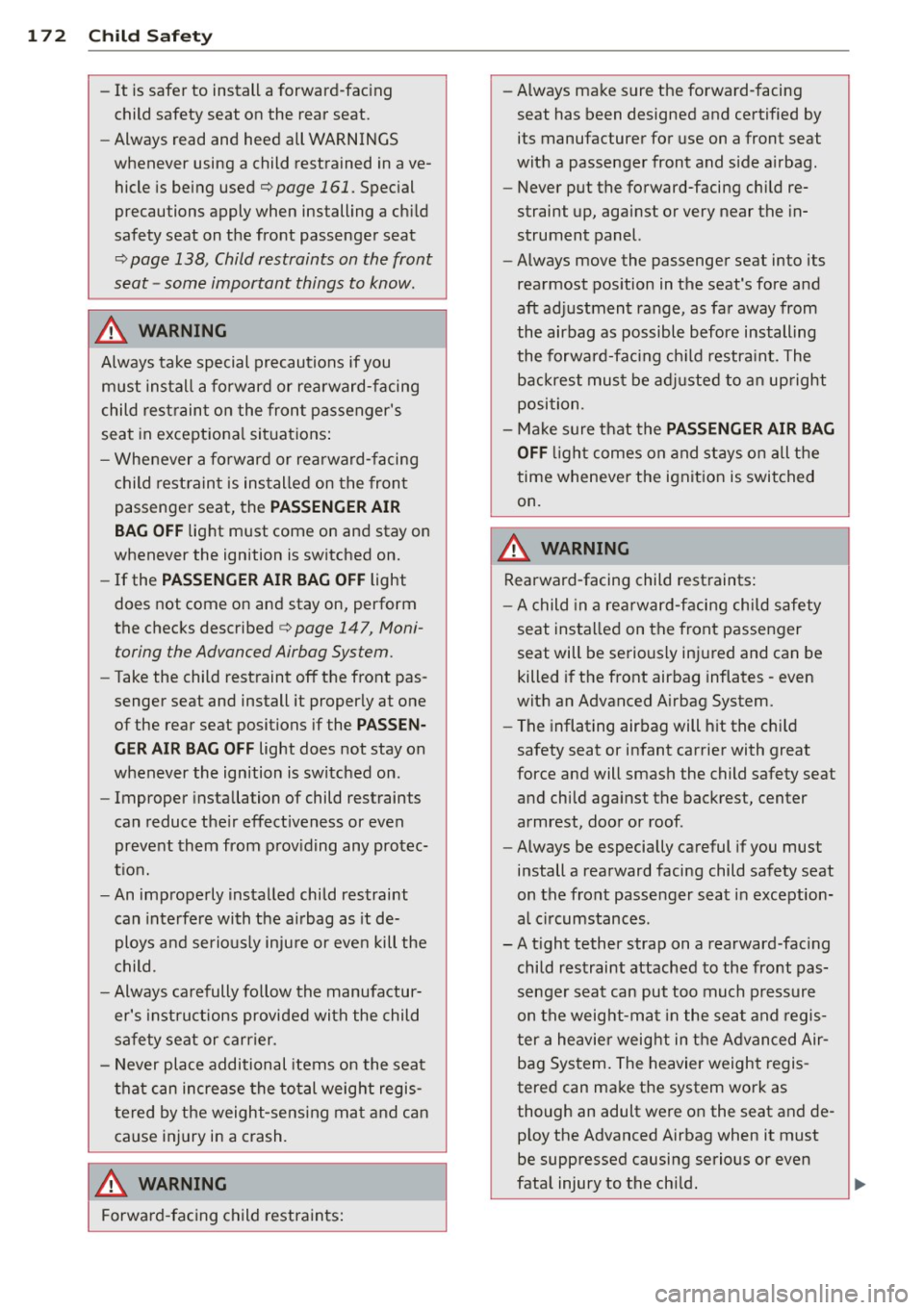
172 Child Safety
-It is safer to install a forward-facing
child safety seat on the rear seat.
- Always read and heed all WARNINGS
whenever using a child restrained in ave
hicle is being used
c::;, page 161. Special
precautions apply when installing a child
safety seat on the front passenger seat
c::;, page 138, Child restraints on the front
seat -some important things to know.
A WARNING
Always take special precautions if you
must install a forward or rearward-facing
child restraint on the front passenger's
seat in exceptional situations:
- Whenever a forward or rearward-facing
child restraint is installed on the front
passenger seat, the
PASSENGER AIR
BAG OFF
light must come on and stay on
whenever the ignition is switched on.
- If the
PASSENGER AIR BAG OFF light
does not come on and stay on, perform
the checks described
c::;, page 147, Moni
toring the Advanced Airbag System.
- Take the child restraint off the front pas
senger seat and install it properly at one
of the rear seat positions if the
PASSEN
GER AIR BAG OFF
light does not stay on
whenever the ignition is switched on .
- Improper installation of child restraints
can reduce their effectiveness or even
prevent them from providing any protec
tion.
- An improperly installed child restraint
can interfere with the airbag as it de
ploys and seriously injure or even kill the
child.
- Always carefully follow the manufactur
er's instructions provided with the child
safety seat or carrier.
- Never place additional items on the seat
that can increase the total weight regis
tered by the weight-sensing mat and can
cause injury in a crash.
A WARNING
Forward-facing child restraints: -
Always make sure the forward-facing
seat has been designed and certified by
its manufacturer for use on a front seat
with a passenger front and side airbag .
- Never put the forward-facing child re
straint up, against or very near the in
strument panel.
- Always move the passenger seat into its
rearmost position in the seat's fore and
aft adjustment range, as far away from
the airbag as possible before installing
the forward-facing child restraint. The
backrest must be adjusted to an upright
position.
- Make sure that the
PASSENGER AIR BAG
OFF
light comes on and stays on all the
time whenever the ignition is switched
on.
A WARNING ~
Rearward-facing child restraints:
- A child in a rearward-facing child safety
seat installed on the front passenger
seat will be seriously injured and can be
killed if the front airbag inflates - even
with an Advanced Airbag System.
- The inflating airbag will hit the child
safety seat or infant carrier with great
force and will smash the child safety seat
and child against the backrest, center
armrest, door or roof.
- Always be especially careful if you must
install a rearward facing child safety seat
on the front passenger seat in exception
al circumstances .
- A tight tether strap on a rearward -facing
child restraint attached to the front pas
senger seat can put too much pressure
on the weight-mat in the seat and regis
ter a heavier weight in the Advanced Air
bag System. The heavier weight regis
tered can make the system work as
though an adult were on the seat and de
ploy the Advanced Airbag when it must
be suppressed causing serious or even
fatal injury to the child.
Page 175 of 286
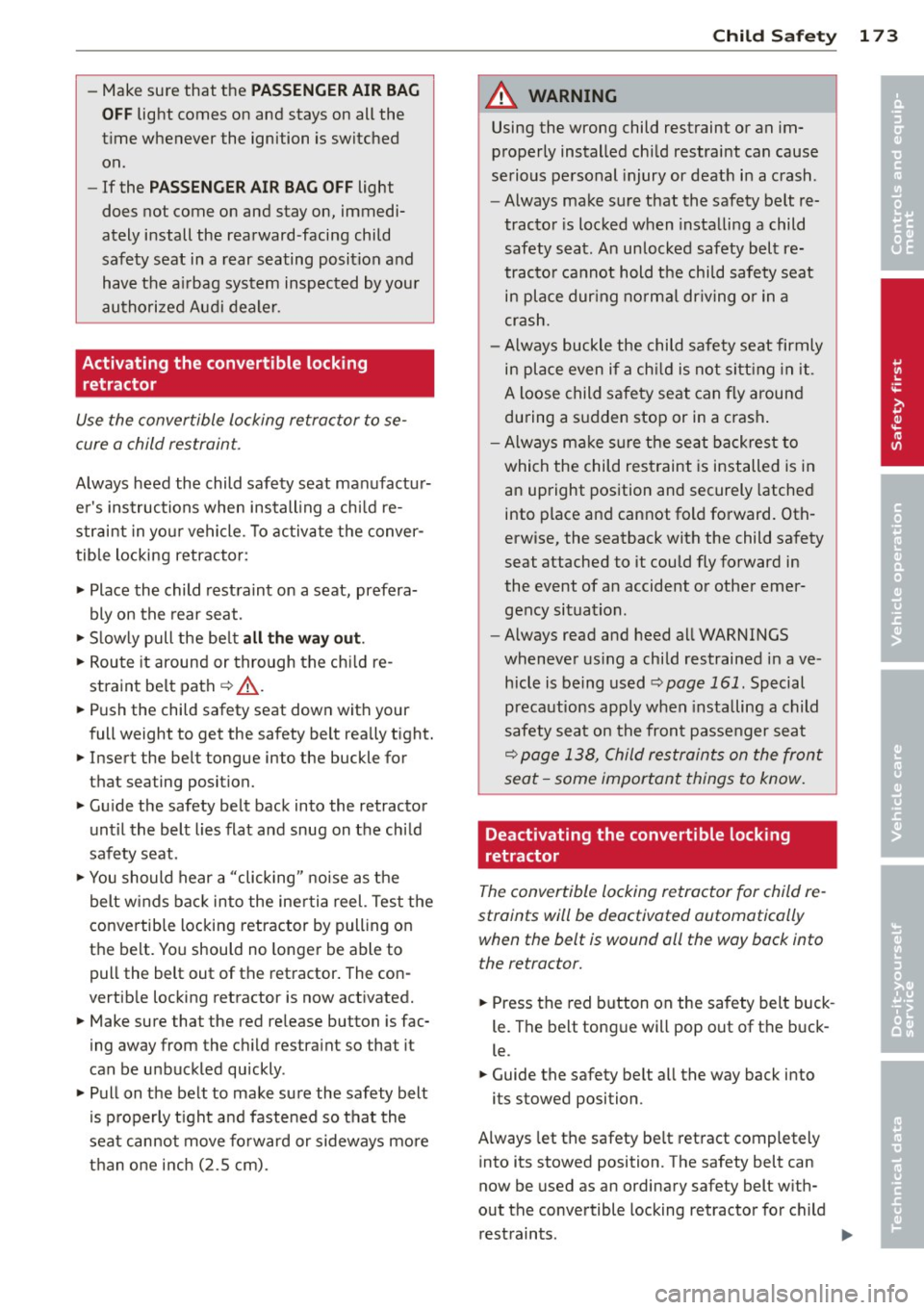
-Make sure that the PASSENGER AIR BAG
OFF
light comes on and stays on all the
time whenever the ignition is switched on.
- If the
PASSENGER AIR BAG OFF light
does not come on and stay on, immedi
ately install the rearward -facing child
safety seat in a rear seating position and
have the airbag system inspected by your
authorized Audi dealer.
Activating the convertible locking retractor
Use the convertible locking retractor to se
cure a child restraint .
Always heed the child safety seat manufactur
er's instructions when installing a child re
straint in your vehicle. To activate the conver
tible locking retractor :
.,. Place the child restraint on a seat, prefera
bly on the rear seat.
.,. Slowly pull the belt
all the way out.
.,. Route it around or through the child re
straint belt path¢.&_ .
.,. Push the child safety seat down with your
full weight to get the safety belt really tight.
.,. Inser t the belt tongue into the buckle for
that sea ting position .
.,. Guide the safety belt back into the retractor
until the belt lies flat and snug on the child
safety seat .
.,. You should hear a "clicking " noise as the
belt winds back into the inertia reel. Test the
convertible locking retractor by pulling on
the belt . You should no longer be able to
pull the belt out of the retractor. The con
vertible locking retractor is now activated.
.,. Make sure that the red release button is fac
ing away from the child restraint so that it
can be unbuckled quickly .
.,. Pull on the belt to make sure the safety belt
is properly tight and fastened so that the
seat cannot move forward or sideways more
than one inch (2.5 cm).
Child Safety 173
A WARNING
Using the wrong child restraint or an im
properly installed child restraint can cause
serious personal injury or death in a crash .
- Always make sure that the safety belt re-
tractor is locked when installing a child
safety seat. An unlocked safety belt re
tractor cannot hold the child safety seat in place during normal driving or in a
crash.
- Always buckle the child safety seat firmly
in place even if a child is not sitting in it.
A loose child safety seat can fly around
during a sudden stop or in a crash.
- Always make sure the seat backrest to
which the child restraint is installed is in
an upright position and securely latched
into place and cannot fold forward. Oth
erwise, the seatback with the child safety
seat attached to it could fly forward in
the event of an accident or other emer gency situation.
- Always read and heed all WARNINGS
whenever using a child restrained in ave
hicle is being used ¢
page 161. Special
precautions apply when installing a child
safety seat on the front passenger seat
¢ page 138, Child restraints on the front
seat -some important things to know.
-
Deactivating the convertible locking
retractor
The conv ertibl e locking retractor for child r e
straints will be deactivated automatically when the belt is wound all the way back into
the retractor.
.,. Press the red button on the safety belt buck
le . The belt tongue will pop out of the buck
le .
.,. Guide the s afety belt all the way back into
i t s s towed position .
Always let the safety belt retract completely
into its stowed position. The safety belt can
now be used as an ordinary safety belt with
out the convertible locking retractor for child
restraints.
•
•
Page 176 of 286
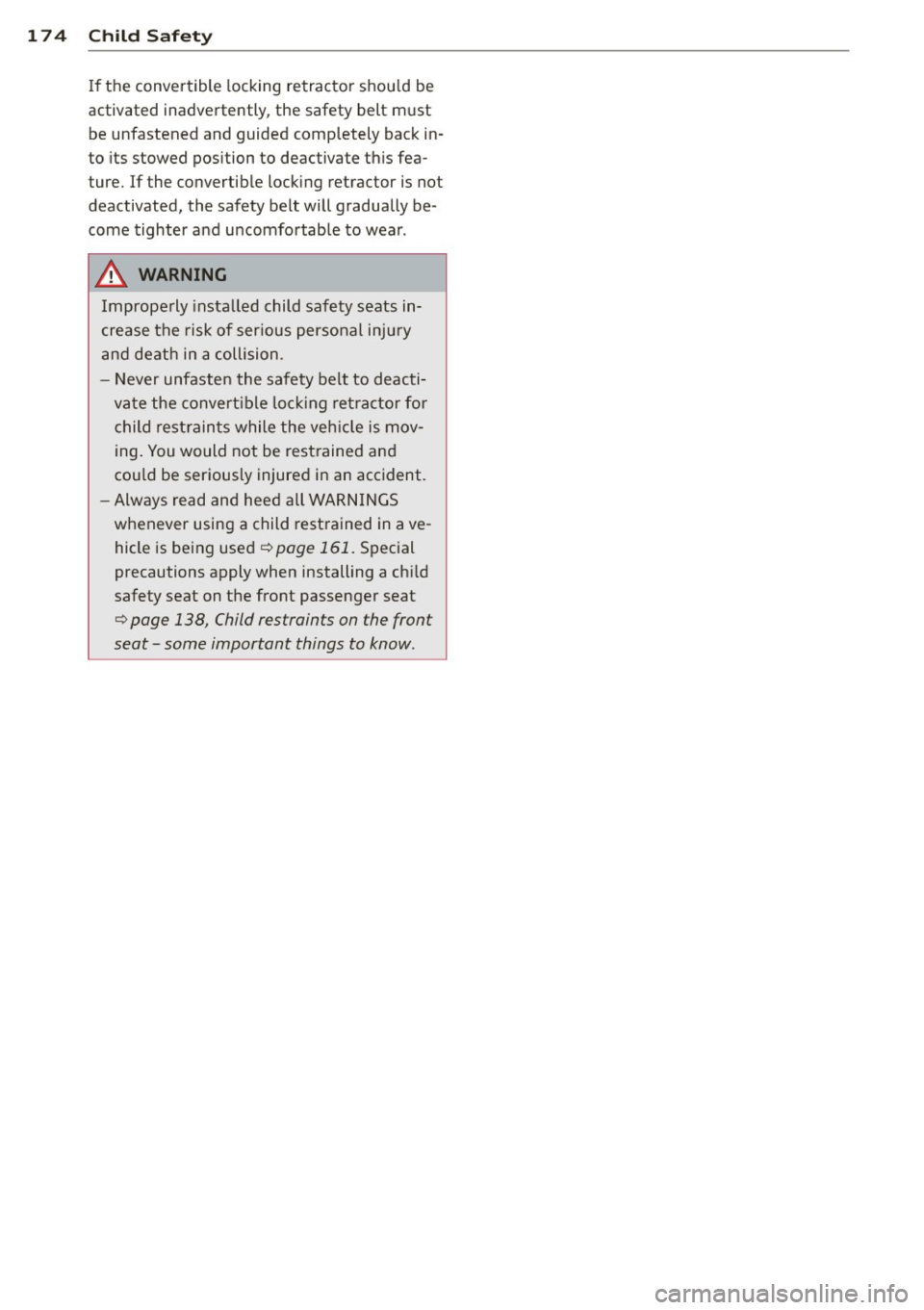
174 Child Saf ety
If the convertible locking retracto r shou ld be
activated inadvertently, the safety belt must be unfastened and guided completely back in
to its stowed pos ition to deactivate th is fea
ture. If the convertible locking retractor is not
deactivated, the safety belt will gradually be
come tighter a nd uncomfortable to wear.
A WARNING
Improperly insta lled child safety seats in
crease the risk of ser ious personal inju ry
and death in a collision.
- Never unfasten the safety belt to deacti
vate the convert ible lock ing retractor for
child rest rain ts while the veh icle is mov
ing. You would not be restrained and
cou ld be ser iously injured in an accident.
- Always read and heed all WARNI NGS
whenever using a child rest rained in ave
hicle is being used
¢ page 161. Special
precautions apply when installing a ch ild
safety seat on the front passenger seat
¢ page 138, Child restraints on the front
seat -some important things to know.
Page 177 of 286
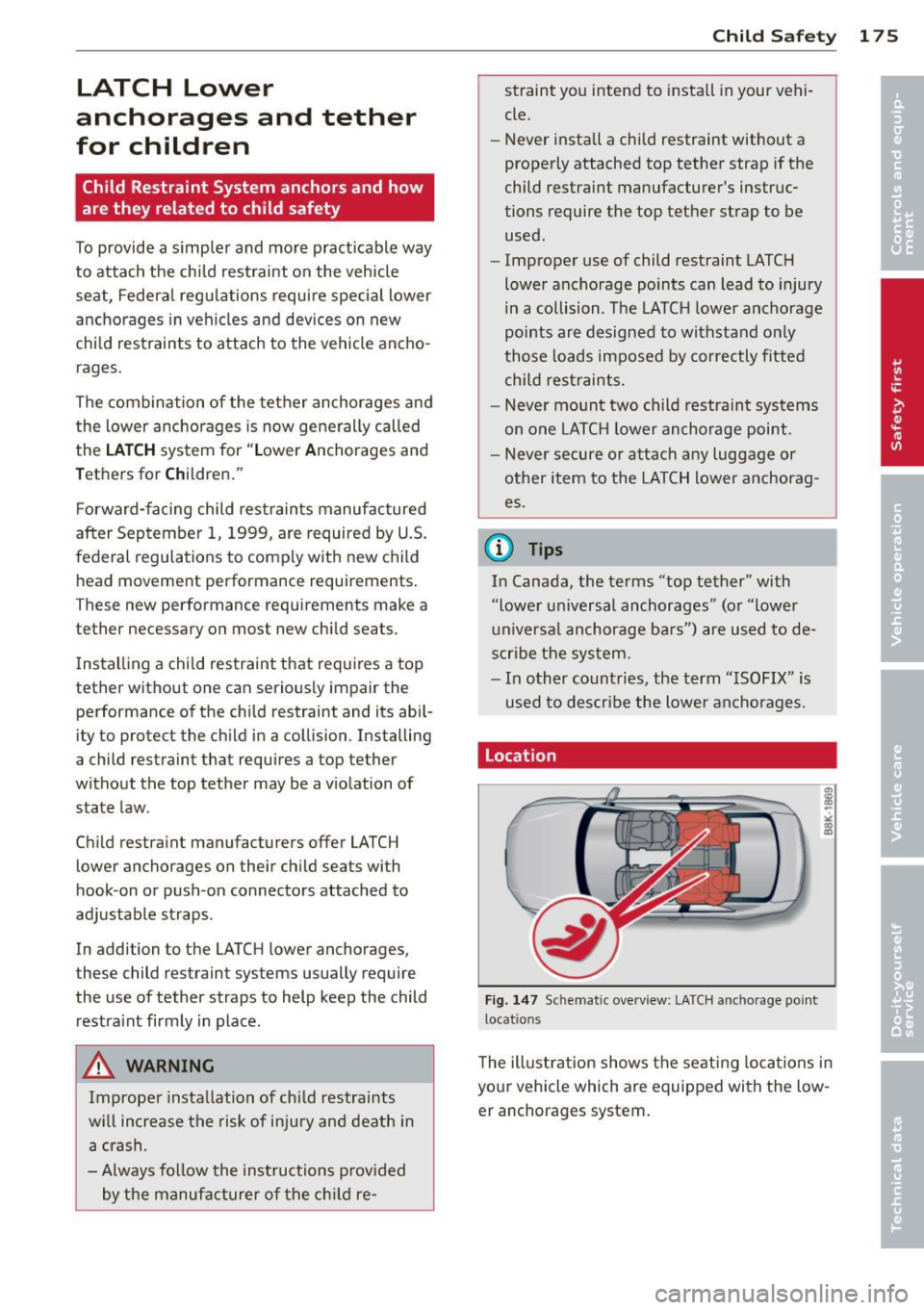
LATCH Lower
anchorages and tether
for children
Child Restraint System anchors and how
are they related to child safety
To provide a s impler and more pract icable way
to attach the child restraint on the vehicle
seat, Federal regu lations require special lower
anchorages in vehicles and dev ices on new
child restraints to attach to the vehicle ancho
rages.
The combination of the tether anchorages and
the lower anchorages is now generally called
the
LA TCH system for "Lower Anchorages and
Tethers for Children ."
F orward-facing child restraints manufactured
after September 1, 1999, are required by U.S.
federal regulations to comply with new ch ild
head movement performance requirements .
T hese new performance requirements make a
tether necessary on most new child seats.
I nstalling a chi ld restraint that requires a top
tether without one can seriously impair the
performance of the chi ld restraint and its ab il
ity to protect the child in a co llision . Installing
a child restraint that requires a top tether
without the top tether may be a v iolation of
state law.
Ch ild restraint manufacturers offer LATCH
lower anchorages on their ch ild seats with
hook -on or push-on connectors attached to
adj ustable straps.
In addition to the LATCH lower anchorages,
these child restraint systems usually require
the use of tether straps to help keep the child
restra int firmly in place .
A WARNING
Improper insta llation of chi ld restraints
w ill increase the risk of inju ry and death in
a crash.
- Always follow the instructions p rov ided
by the manufacturer of the ch ild re-
Child S afety 175
straint you intend to install in your vehi
cle.
- Never install a chi ld restraint without a
properly attached top tether strap if the
child restraint manufacturer's instruc
tions require the top tether strap to be
used.
- Improper use of child restraint LATC H
lower anchorage points can lead to injury
in a collision . The LATC H lowe r anchorage
points ar e designed to withstand on ly
those loads imposed by correctly fitted
child restraints.
- Never mo unt two ch ild restra int systems
on one LATC H lower anchorage point.
- Never secure or a ttach any luggage or
o ther item to the LATCH lower anchorag
es.
a) Tips
In Canada, the terms "top tether" with
"lower u niversal anchorages" (or "lower
universa l anchorage ba rs") are used to de
scribe the sys tem.
- In other countries, the t erm " ISOFIX" is
used to describe the lower a nch o rages.
Location
Fi g. 14 7 Schema tic overv iew: LA TCH ancho rage point
l ocations
T he illust rat ion shows the seati ng loca tions in
yo ur vehicle which are equipped with the low
er anchorages system.
Page 178 of 286
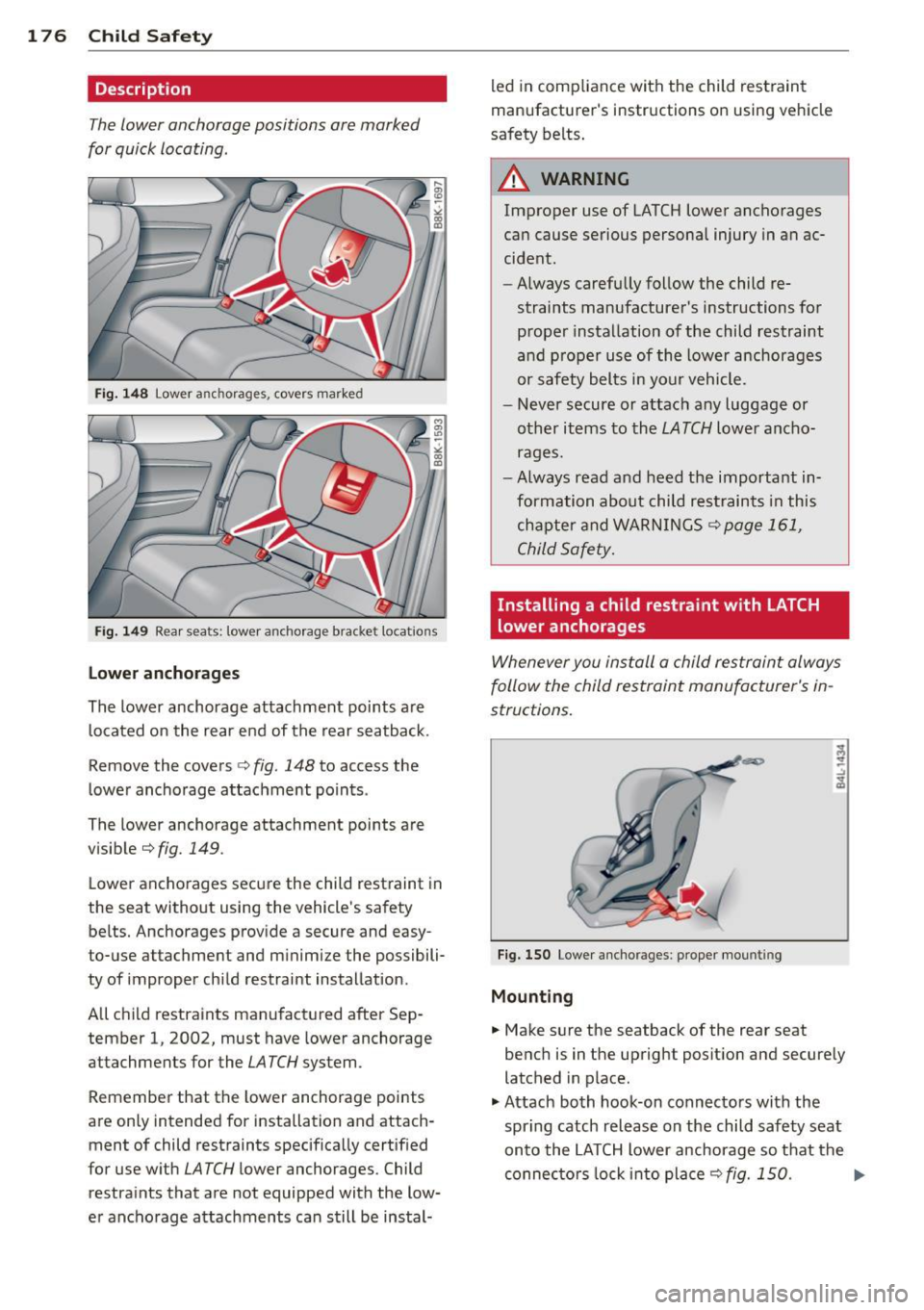
1 7 6 Child S afet y
Description
The lower anchorage positions are marked
for quick locating.
Fig . 14 8 Lower anchorages, covers marked
Fi g. 1 49 Rear seats: lower anchorage bracket locations
lower ancho rages
The lower anchorage attachment points are
l ocated on the rear end of the rear seatback.
Remove the covers
c::> fig . 148 to access the
lower anchorage attachment points .
The lower anchorage attachment points are visible
c::> fig. 149.
Lower anchorages secure the child restraint in
the seat without using the vehicle's safety belts. Anchorages provide a secure and easy
to-use attachment and minimize the possibili
ty of improper child restraint installation.
A ll child restraints manufactured after Sep
tember 1, 2002, must have lower anchorage
attachments for the
LATCH system.
Remember that the lower anchorage points
are on ly intended for installation and attach
ment of child restraints specifically certified
for use with
LATCH lower anchorages . Child
restraints that are not equipped with the low
er anchorage attachments can still be instal- led in compliance with the child restraint
manufacturer's
instructions on using vehicle
safety belts .
A WARNING
-Improper use of LATCH lower anchorages
can cause serious personal injury in an ac
cident.
- Always carefully follow the child re
straints manufacturer's instructions for
proper installation of the child restraint
an d prope r use of the lower anchorages
or safety belts in your vehicle.
- Never secure or attach any luggage or
other items to the
LATCH lower ancho
rages.
- Always read and heed the important in
formation about child restraints in this
chapter and WARN INGS
c::>page 161,
Child Safety.
Installing a child restraint with LATCH
lower anchorages
Whenever you install a child restraint always
follow the child restraint manufacturer's in
structions.
F ig. 150 Lower anc horages: proper mount ing
Mounting
.. Make sure the seatback of the rear seat
benc h is in the upright posit ion and securely
latched in place .
"' Attach both hook-on connectors with the
spr ing catch release on the child safety seat
onto the LATCH lower anchorage so that the
connec to rs lock into place
c::> fig. 150. IJII,
Page 179 of 286
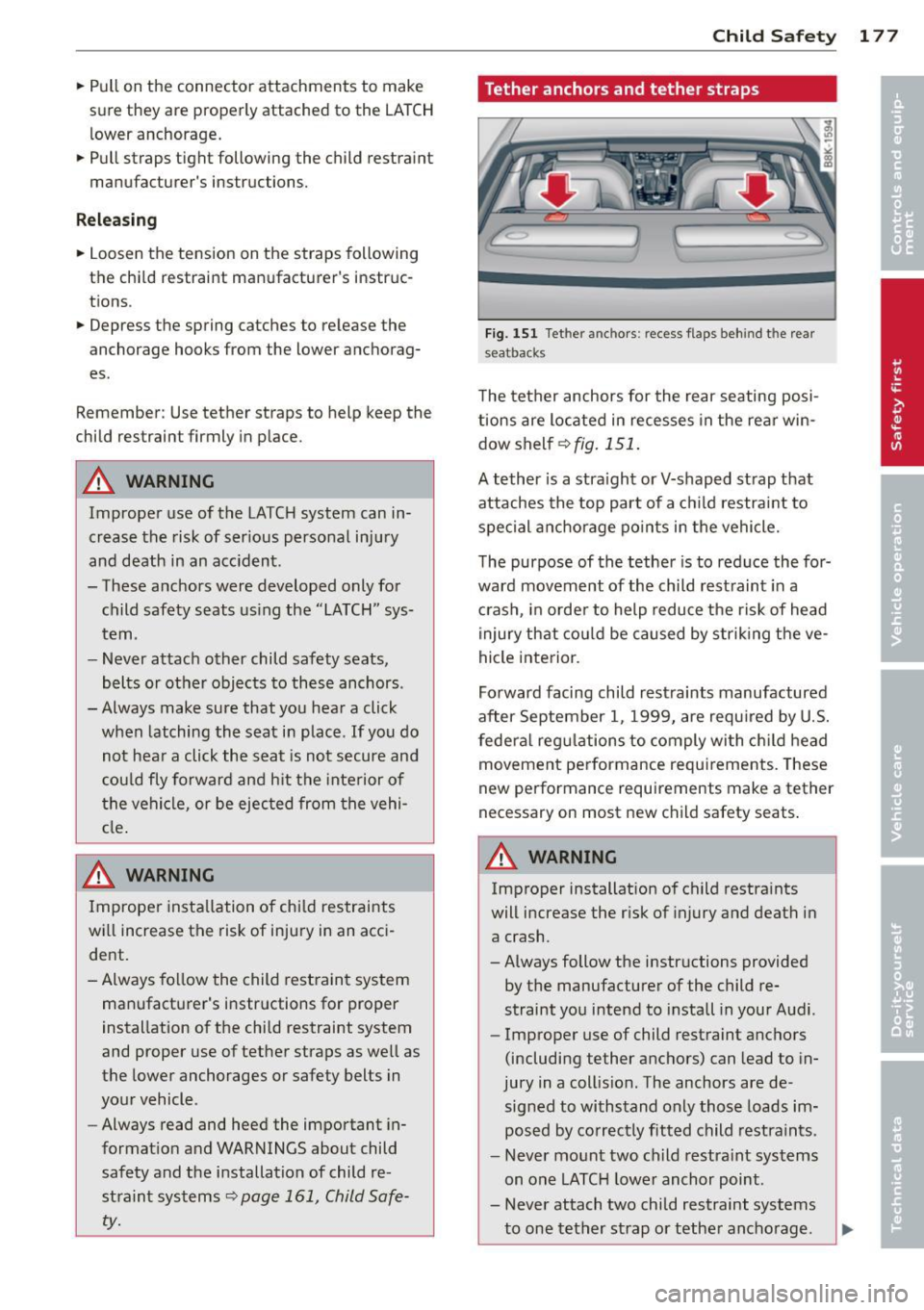
.. Pull on the connector attachments to make
sure they are properly attached to the LATCH
lower anchorage .
.. Pull straps tight following the child restraint
manufacturer 's instructions.
Re lea sin g
.. Loosen the tension on the straps following
the chi ld restraint manufacturer's instruc
tions .
.,. Depress the spring catches to release the
anchorage hooks from the lower anchorag
es .
Remember: Use tether straps to help keep the
child restraint firmly in place.
A WARNING
Improper use of the LATC H system can in
crease the risk of ser ious personal injury
and death in an acc ident.
- These anchors were developed only for child safety seats us ing the "LATCH" sys
tem.
- Never attach other child safety seats,
belts or other objects to these anchors .
- Always make sure that you hear a click when latching the seat in place . If you do
not hea r a click the seat is not secure and
c ou ld fly forward and h it the inte rior of
the vehicle, or be ejected from the vehi
cle .
A WARNING
Improper installation of chi ld restraints
w ill increase the risk of in jury in an acci
dent.
- Always fo llow the child rest raint system
manufacturer's instr uctions for proper
installation o f the child restraint system
and proper use of tether straps as we ll as
the lower anchorages or safety belts in
your vehicle .
- Always read and heed the important in
format io n and WARNINGS about child
safety and the installation of child re
st raint systems~
page 161, Child Safe
ty.
-
Child S afety 177
Tether anchors and tether straps
Fig. 151 Tet her anchors: recess flaps behind the rear
seatbacks
T he te ther anchors for the rear seating posi
tions are located in recesses in the rear win
dow shel f¢
fig. 151 .
A tether is a stra ight or V-shaped st rap that
attaches the top par t of a ch ild restrai nt to
special a nchorage po ints in the vehicle.
T he purpose of the tether is to reduce the for
ward movement of the child rest raint in a
c rash, i n orde r to help reduce the risk of head
injury that cou ld be caused by strik ing the ve
hicle inte rior.
Fo rward facing child restraints manufactured
after September 1, 1999, are requ ired by U.S.
federa l reg ulations to comply wi th ch ild head
movement pe rformance requi rements. These
new performance requirements make a tether
necessary on most new child safety seats .
A WARNING
Improper installation of child restra ints
will increase the r isk of injury and death in
a crash.
-Always follow the instr uctions provided
by the manufacturer of the child re
straint you intend to install in your Audi.
- Improper use of child restraint anchors
(including tether anchors) can lead to in
jury in a coll ision. The anchors are de
signed to withstand only those loads im posed by co rrectly fitt ed child restraints.
- Neve r mo unt two child rest ra int systems
on one LATC H lower anchor point.
- Never attach two child restraint systems to one tether strap o r tethe r ancho rage .
-
Page 180 of 286
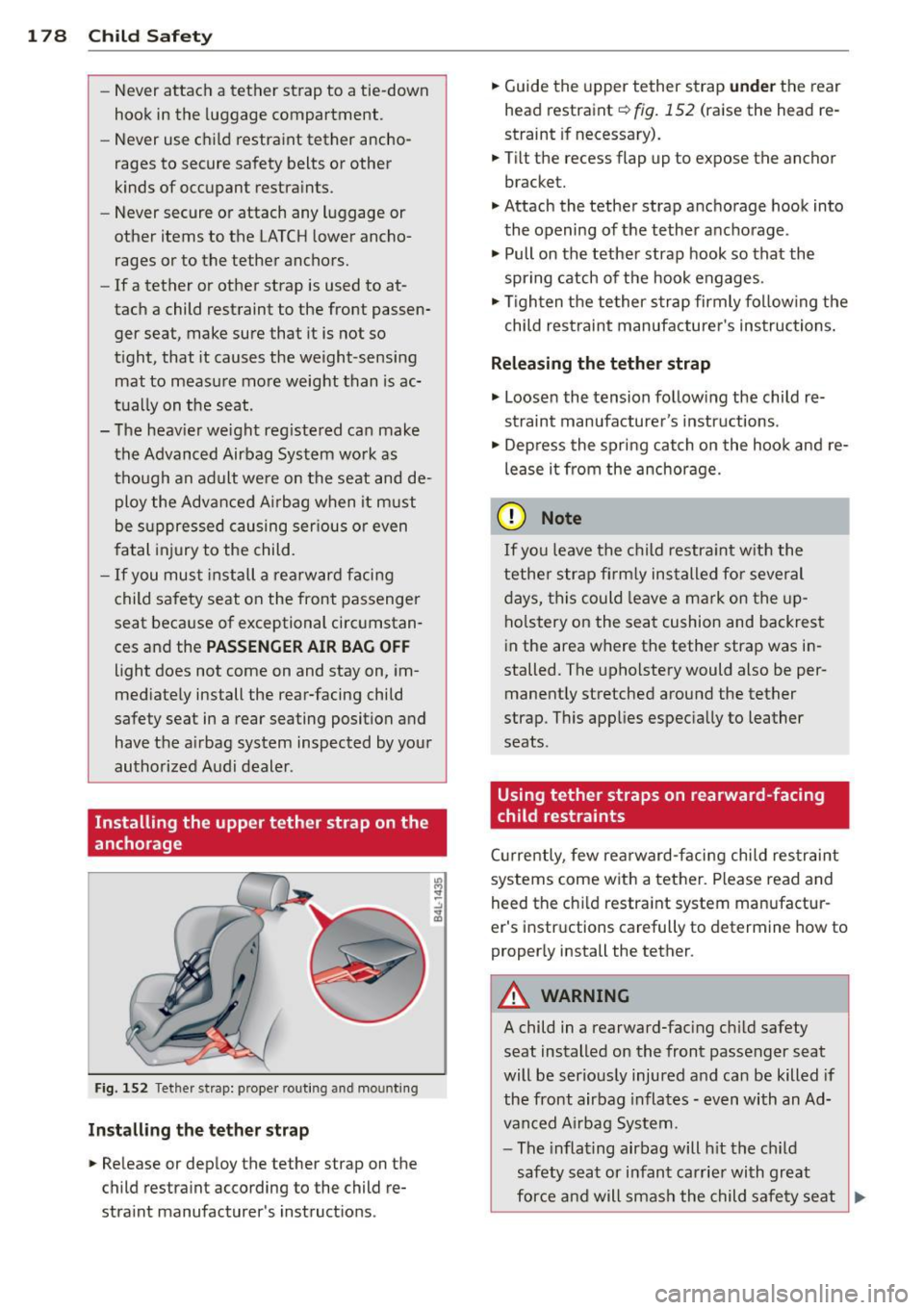
1 78 Child Safety
-Never attach a tether strap to a tie-down
hook in the luggage compartment .
- Never use child restraint tether ancho
rages to secure safety belts or other
kinds of occupant restraints.
- Never secure or attach any luggage or
other items to the LATCH lower ancho
rages or to the tether anchors.
- If a tether or other strap is used to at
tach a child restraint to the front passen
ger seat, make sure that it is not so
tight, that it causes the weight-sensing
mat to measure more weight than is ac
tually on the seat.
- The heavier weight registered can make
the Advanced Airbag System work as
though an adult were on the seat and de
ploy the Advanced Airbag when it must
be suppressed causing serious or even
fatal injury to the child.
-If you must install a rearward facing
child safety seat on the front passenger
seat because of exceptional circumstan
ces and the
PASSENGER AIR BAG OFF
light does not come on and stay on, im
mediately install the rear-facing child
safety seat in a rear seating position and
have the airbag system inspected by your
authorized Audi dealer.
Installing the upper tether strap on the
anchorage
Fig. 1S2 Tethe r strap: prope r routing and mounting
Installing the tether strap
.,. Release or deploy the tether strap on the
child restraint according to the child re
straint manufacturer's instructions. .,.
Guide the upper tether strap
under the rear
head restraint co
fig. 152 (raise the head re
straint if necessary).
.,. Tilt the recess flap up to expose the anchor
bracket.
.,. Attach the tether strap anchorage hook into
the opening of the tether anchorage.
.,. Pull on the tether strap hook so that the
spring catch of the hook engages .
.,. Tighten the tether strap firmly following the
child restraint manufacturer's instructions.
Releasing the tether strap
.,. Loosen the tension following the child re
straint manufacturer's instructions.
.,. Depress the spring catch on the hook and re
lease it from the anchorage.
(D Note
If you leave the child restraint with the
tether strap firmly installed for several
days, this could leave a mark on the up
holstery on the seat cushion and backrest
in the area where the tether strap was in
stalled. The upholstery would also be per
manently stretched around the tether
strap. This applies especially to leather
seats .
Using tether straps on rearward-facing
child restraints
Currently, few rearward-facing child restraint
systems come with a tether. Please read and
heed the child restraint system manufactur
er's instructions carefully to determine how to
properly install the tether .
A WARNING ~ -
A child in a rearward-facing child safety
seat installed on the front passenger seat
will be seriously injured and can be killed if
the front airbag inflates -even with an Ad
vanced Airbag System.
- The inflating airbag will hit the child
safety seat or infant carrier with great
force and will smash the child safety seat ..,.